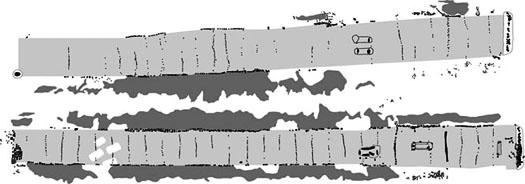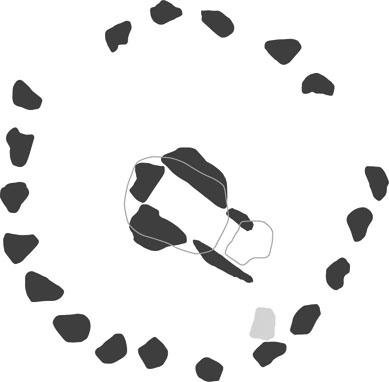Long barrows, dolmens and passage graves
The shape of burial mounds changed during the Neolithic period. The so-called long barrows are the earliest, next came the dolmens and afterwards the passage graves.
The earliest long barrows (3800-3500 BC)
Not long after the introduction of agriculture farmers began building monumental tombs for people of special importance. At first they built long barrows of earth over wooden burial chambers. The earthen long barrows were oriented east-west and were widest at the eastern end, where there was a façade of large posts. This was where rituals took place. The long barrows of earth and wood were precursors of the dolmens with their chambers of stone.

Dolmens of stone (3500-3200 BC)
The dolmens were built of large granite blocks. The oldest dolmen chambers are small and thought to have been for single burials. Later the dolmen chambers became larger and an entrance was added, so they could be used for several burials. The dolmen chambers were covered with an oblong or round mound. The weather has often taken its toll on the dolmens, so that the mound itself has usually been eroded away. This leaves only the characteristic burial chambers, which were originally covered. 2300 dolmens are preserved in Denmark, only a tenth of the original number.

Passage graves (3250-3100 BC)
The passage graves are larger than the dolmens and have space for many burials. They testify to a highly-developed construction technology. The passage graves were built over a relatively short period of time, but subsequently were used for burials throughout the remainder of the Neolithic period and sometimes also in the Bronze Age. The chambers are furnished with a narrow passage, so that the home of the dead could be visited again and again. Around 500 passage graves are preserved in Denmark, but there may originally have been ten times as many. Passage graves are known as jættestuer in Danish, which means ‘giants’ living rooms’. They have this name because, according to popular belief, it was thought that these large monuments had been built by beings with supernatural powers – such as giants.
Saxo Grammaticus, Denmark’s first historian, wrote in his preface to ‘The history of the Danes’: ”That the Danish area was once cultivated by a civilisation of giants is testified by the immense stones attached to ancient barrows and caves”.


